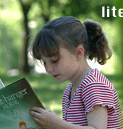Activities to support letter patterns: phonological
and phonemic awareness activities
The types of activities useful at each year level are shown in
the following table.
| Prep
Recall how to say words
|
- spontaneous conversation; talk about pictures seen,
experiences.
- learn to say words, imitate words of increasing complexity
in play.
- recall the names of familiar objects and events, recalling
names faster.
- recall a sequence of names, for example, numbers one
to ten, versions of "I went window shopping", for
example, "I went to beach and saw a seagull", "I
went to beach and saw a seagull and a fish", ......
- recognise and say rhyming words and words that alliterate.
- listen for and remember a shared sound.
|
| Grade 1 - 2
Segment words into sounds and blend
|
- segment words into onset and rime.
- identify the first sound and the last sound in words.
- segment a word into sounds, tap for each sound, and count
the sounds in a word.
- blend onset and rime to make a word
.
- blend a sequence of sounds to make a word.
- segment 2- 3- or 4- syllable words into syllables by clapping,
saying each syllable and say each sound.
- comprehend short vs long vowel sound.
|
| Grade 3
Manipulate sounds in 1- syllable word
|
- delete a sound from a word and saying the word left.
- substitute one sound for another.
- identify sound shared by 2 or more words.
- syllabify multi-syllabic words.
- recognise syllables or morphemes in oral language, segment
words into functional groups of sounds, (for example, look-ed,
in-side, terr-ible).
- categorising sound groups, for example, long versus short
sounds.
- listening for a sound pattern in multi-syllabic words.
|
| Grade 4 + |
- pronounce more sophisticated words.
- recognise the same sound segment in 2- and 3- syllable words.
- blend 2-, 3- syllables to match a known word by modifying
the stress pattern.
- discuss stress patterns, recognise the schwa in 2- and 3-
syllable words.
- segment 2- and 3- syllable words into sounds, recognising
the schwa.
- recalling multi-syllabic words that share a sound pattern,
for example, "inside", "preside" ......
or "microphone, microbe ......", or that rhyme, etc.
|

